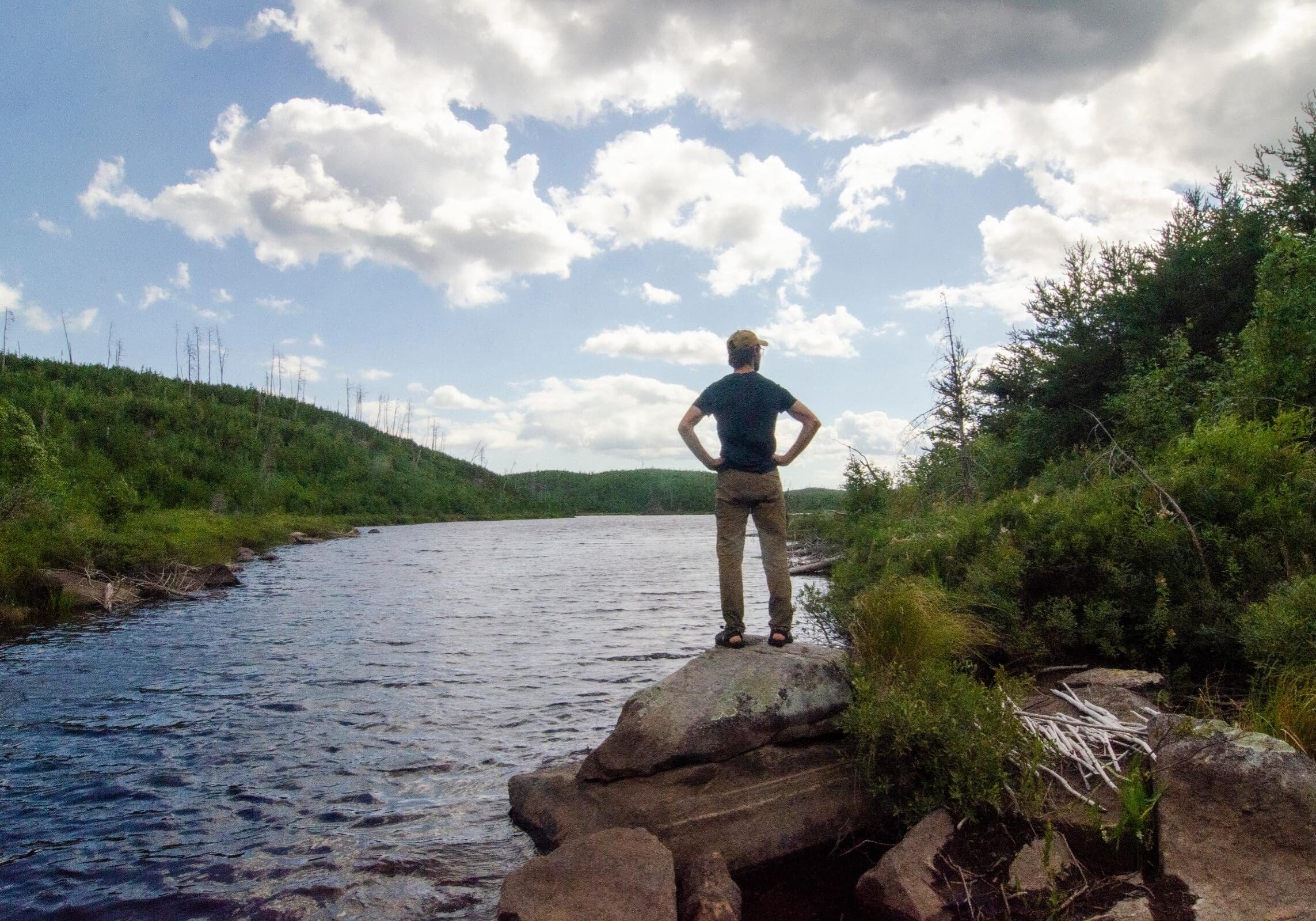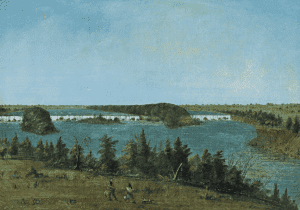Finding a great campsite can be one of the great joys of a canoe trip. Waking up in a stand of majestic pines, enjoying a cool breeze rolling off the lake on a midsummer afternoon, and cooking over a campfire without worrying about bugs can make a campsite that much more memorable.
Occasionally, these sites are discovered by delightful accident. But consistently finding the best campsites often takes a little more work and wilderness savvy. Here are a few subtle guide tricks for finding memorable Boundary Waters campsites.
1. Find a west-facing site
Wind often comes from the west in the BWCAW. In the summer, finding a site with western exposure helps keep camp cool and blow away the mosquitoes. Of course, in early spring and fall when bugs aren’t an issue, just the opposite might hold true if you want to escape the wind in the colder temperatures.
2. Look for mature pines clear of underbrush
Sites with mature pines and an open forest floor often have fewer bugs.
While thick underbrush and swampy areas hold bugs, the breezy, open forest floor and lack of favored habitat in some mature pine stands tend to keep the bugs away for much of the day.
Not to mention that camping in a majestic pine forest carpeted in soft pine needles is one of the joys of canoe country.
3. Travel early in the day and beat the crowds
Sunrise is often the most peaceful, beautiful time of day in the Boundary Waters. The wind has yet to pick up, the wildlife is undisturbed and active, and many other groups are still asleep. And paddling in the cool of morning is a welcome escape from hot summer afternoons.
While the BWCAW is still a secluded refuge from civilization, during peak paddling season (late June through mid August) you’ll probably run into plenty of other paddlers, especially near entry points and the more popular lakes. By aiming to reach your destination campsite around lunch or shortly thereafter, you’ll beat most of the crowds and often have the first choice of campsites on your target lake. And it’s a mighty fine feeling to eat lunch at that beautiful five-star campsite while watching other groups paddle by. Arriving early in the day also allows time to relax and enjoy the rest of the afternoon in camp.
4. Scout ahead of time with online tools
Using the internet to scout campsites and portages might feel like cheating to some. It’s completely understandable if this diminishes the simplicity and delightful unknowns of a BWCAW canoe trip for you. But knowing the lay of the land and reading trip reports from other paddlers can lead to a very enjoyable trip, still full of adventure and curiosity fueled by the hints and descriptions found online. When time in the woods is at a premium (which it is for most folks, myself included), knowing which campsites are favorable can save time and travel. And a great campsite can make a trip that much sweeter.
Two favorites include paddleplanner.com and bwca.com
5. Look out for widowers!
Be sure to check your site for dead or unhealthy trees or branches hanging over tent pads, especially if in the warm months of summer when thunderstorms are common. Find the “lightning tree” (the tallest in the area) to gauge where lightning strikes pose the most risk, as root systems sprawling away from the tree can carry a lightning strike a long distance. Keep in mind that wind often comes out of the west, though during storms wind direction can be unpredictable. Straight-line winds in the BWCAW are not a joke, and injury or worse from a fallen tree is not worth saving the little bit of extra time it takes to find a site without hazards.
Finding a campsite with fewer bugs, relief from the weather, and a chance to avoid the crowds can help make a canoe trip that much sweeter.
While favorite sites are occasionally discovered unexpectedly, following these tips will help you find favorable campsites more consistently on your next trip into canoe country.
Sign up for our newsletter to receive updates about new articles, great deals, and information about the activities you love and the gear that makes them possible:
Have You Read Our Other Content?
Flying South – Where Do the BW’s Birds Go?
Every winter, the forests of canoe country fall silent as so many of the sounds of summer fade with the season. With the coming of winter’s chill, many of the birds that call these wild shores their summer home head south to milder wintering grounds from the rivers of southern Minnesota, the southern states, all…
Map Mondays – Week 3 – Crab Lake/Cummings Lake to Big Lake
As part of our continuing series on the “route planning game,” we are creating routes using randomly selected entry points, exit points, and number of days to create unique and fun BWCA routes. This week is an arduous 6 night trip through the far western reaches of the BWCA. This area of the BWCA can…
The 12 Longest Portages in Canoe Country
The act of portaging between two waterways is usually, understandably, an intentionally short affair. Paddle to the closest point between two water bodies and then portage. This doesn’t make it easy or “type 1 fun” every time, but it’s the burden we bear for wilderness travel. Some portages stick with us whether they are steep…
The Ten Most Challenging BWCA Lakes to Visit
The Boundary Water Canoe Area Wilderness encompasses over a million acres and 1100 named lakes interconnected by portages and streams, but sometimes that vast expanse can feel a little cramped, especially along entries where larger numbers of groups congregate. For the cynic who feels the BWCA is lacking some inherent quality of wilderness in this…
A Fire Perspective: 200 Years of Wildfires
Few natural processes inspire the fear and awe that wildfires do. In nature, fire is a seeming paradox of death and new life. Gigantic, swirling infernos that engulf the landscape in an unheeding wall of flame become landscape-level scars healed by green shoots and wildflowers. And here on the southern edge of the boreal forest,…
Wildlife in Wildlands – A History of BWCA Wildlife
The Boundary Waters Canoe Area Wilderness, Superior National Forest, and Voyageurs National Park make up the largest wild landscape in Minnesota as well as being one of the largest wild spaces east of the Mississippi in the US. Combine that with wildlands directly across the border in Quetico Provincial Park and the surrounding crownlands, and…
Is it possible to visit EVERY lake in the BWCA?
This is one of those funny questions. I don’t know if other major BWCA trip enthusiasts have had to encounter it, but I certainly have. It usually comes from someone that isn’t that familiar with the Boundary Waters who, upon hearing of your adventures and how much time you’ve spent, wonders if you’ve been to…
Gear Features: We’ve got your back(straps)!
At Portage North and Sundog Sport, we sell gear that we would want to use and that we can trust. In that pursuit, we are constantly improving our gear so that it can be more enjoyable to use, more trustworthy, and easier to make to a high standard. Much has changed since Portage North…
Footsteps of the Past – Tracing Minnesota’s Historic Portages
. In 1992, a report was concluded as portages of historical significance were surveyed in order to be included in a bid for the National Register of Historic Places. As part of this survey, archeologists looked for signs of the past and recorded the conditions of the trails and how time had changed them. The results were varied. Some trails had vanished completely or become so overgrown that they were nearly impossible to follow. In a few places in Minnesota though, there are still opportunities to trod in the tread of voyageurs and native peoples alike with a canoe on your shoulders and a sense of adventure in your heart. The spirit of the portage is still very much alive in the land of 10,000 lakes. Here are some of the most historic portages in the state.











